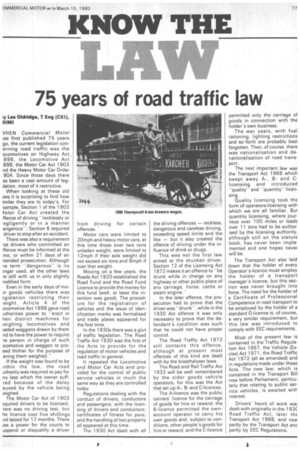75 years of road traffic law
Page 79

If you've noticed an error in this article please click here to report it so we can fix it.
ly Les Oldridge. T Eng (CEI), /IIMI VHEN Commercial Motor as first published 75 years go, the current legislation con erning road traffic was the ocomotives on Highway Act 896, the Locomotive Act 898, the Motor Car Act 1903 nd the Heavy Motor Car Order 904. Since those days there as been a vast amount of legrlation, most of it restrictive. When looking at these old rws it is surprising to find how imilar they are to today's. For xample, Section 1 of the 1903 lotor Car Act created the ffence of driving "recklessly or egligently or in a manner angerous"; Section 6 required driver to stop after an accident. There was also a requirement at drivers who committed an ffence must be informed at the me, or within 21 days of an tended prosecution. Although le term "dangerous" is no )nger used, all the other laws re still with us in only slightly iodified form.
Even in the early days of moDr goods vehicles there was .igislation restricting their /eight. Article 4 of the ocomotive Act 1898 gave road uthorities power to "erect in heir district machines for /eighing locomotives and )aded waggons drawn by them nd to have the power to require -le person in charge of such )comotive and waggon to proeed thither for the purpose of eying them weighed."
If the weight was found to be fithin the law, the road uthority was required to pay for ny loss which the owner suffred because of the delay aused by the vehicle being /eighed.
The Motor Car Act of 1903 aquired drivers to be licensed; lere was no driving test, but he licence cost five shillings nd lasted for 12 months. There /as a power for the courts to uspend or disqualify a driver from driving for certain offences.
Motor cars were limited to 20mph and heavy motor cars, at this time those over two tons unladen weight, were limited to 12mph if their axle weight did not exceed six tons and 8mph if over that weight.
Moving on a few years, the Roads Act 1920 established the Road Fund and the Road Fund Licence to provide the money for this fund (well, at least the intention was good). The procedure for the registration of vehicles and the issue of identification marks was formalised and trade plates appeared for the first time.
In the 1930s there was a glut of traffic legislation. The Road Traffic Act 1930 was the first of the Acts to provide for the regulation of motor vehicles and road traffic in general.
It repealed the Locomotive and Motor Car Acts and provided for the control of public service vehicles in much the same way as they are controlled today.
Regulations dealing with the conduct of drivers, conductors and passengers; with the licensing of drivers and conductors; certificates of fitness for psvs; and the handling of lost property all appeared at this time.
The 1930 Act dealt with all
the driving offences — reckless, dangerous and careless driving, exceeding speed limits and the like — but it also created the offence of driving under the influence of drink or drugs.
This was not the first law aimed at the drunken driver. Section 12 of the Licensing Act 1872 makes it an offence to "be drunk while in charge on any highway or other public place of any carriage, horse, cattle or steam engine."
In the later offence, the prosecution had to prove that the driver was "drunk", while in the 1930 Act offence it was only necessary to prove that the defendant's condition was such that he could not have proper control.
The Road Traffic Act 1972 still contains this offence, although at present most offences of this kind are dealt with by the breathalyser laws.
The Road and Rail Traffic Act 1933 will be well remembered b■',/ the older goods vehicle operators, for this was the Act that set up A-, Band C-licences.
The A-licence was the public carriers' licence for the carriage of goods for hire or reward; the B-licence permitted the ownaccount operator to carry his own goods and, subject to conditions, other people's goods for hire or reward; and the C-licence permitted only the carriage of goods in connection with the holder's own business.
The war years, with fuel rationing, lighting restrictions and so forth are probably best forgotten. Then, of course, there was nationalisation and denationalisation of road transport.
The next important law was the Transport Act 1968 which swept ,away A-, Band Clicensing and introduced "quality" and "quantity" licensing.
Quality licensing took the form of operators-licensing with which we are all familiar. But quantity licensing, where journeys over 100 miles or loads over 11 tons had to be authorised by the licensing authority, although still on the statute book, has never been implemented and one hopes never will be.
The Transport Act also laid down that the holder of every Operator's-licence must employ the holder of a transport manager's licence, but this section was never brought into force. The need for the holder of a Certificate of Professional Competence in road transport to be employed by the holder of a standard 0-licence is, of course, a very similar requirement, but this law was introduced to comply with EEC requirements.
Most of the present law is contained in the Traffic Regulation Act 1967, the Vehicle (Excise) Act 1971, the Road Traffic Act 1972 (all as amended) and in regulations made under these Acts. The new law, which is contained in the Transport Bill now before Parliament, particularly that relating to public service vehicles, is awaited with interest.
Drivers' hours of work wa5. dealt with originally in the 193C Road Traffic Act, later the Transport Act 1968, and no partly by the Transport Act anc partly by EEC Regulations.
































































































































